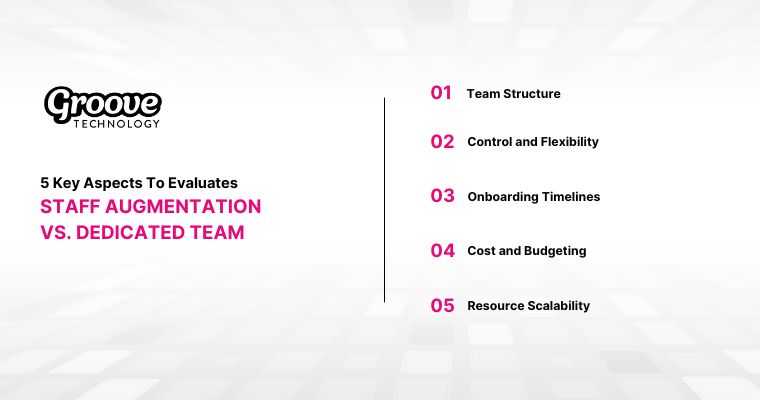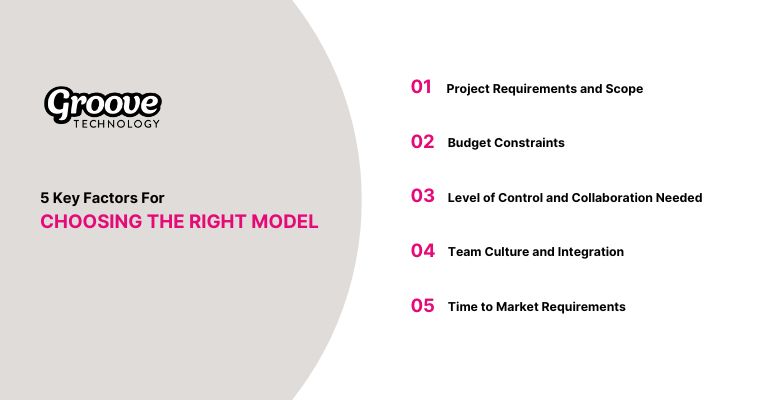Staff Augmentation vs Dedicated Teams: Choosing the Best Option
In the evolving IT outsourcing landscape, businesses face a strategic choice between Staff Augmentation and Dedicated Teams when seeking technical expertise. Staff Augmentation provides flexibility by temporarily integrating specialized professionals into existing teams, particularly effective for time-sensitive projects requiring specific skills. Meanwhile, Dedicated Teams offer a comprehensive solution through sustained collaboration, making them ideal for complex, long-term initiatives demanding consistent focus and team cohesion.
Industry research from Deloitte reveals that 70% of technology companies strategically employ both models to optimize their operations. The selection between these approaches depends on various factors, including project specifications, budget constraints, and organizational goals. Staff Augmentation excels in delivering agility and cost-effectiveness for dynamic requirements, while Dedicated Teams provide stability and seamless integration for extended projects.
Some organizations adopt a hybrid approach, combining elements from both models to create tailored solutions. This decision-making process requires careful consideration of project timelines, scope definition, technical requirements, and corporate culture to determine the most suitable engagement model for achieving business objectives.

What Is Staff Augmentation?
Staff augmentation is a flexible hiring model where you add external experts—often software developers, QA testers, or other specialists—to your existing internal team for a specific period or project. In contrast to permanent hiring, staff augmentation resources usually join your organization on a temporary, project-based, or contractual basis.
This approach allows you to fill skill gaps quickly without the overhead of recruiting, onboarding, and training full-time employees. For example, if you’re working on a short-term project that requires expertise in a specific tech stack (e.g., React.js, Node.js, Kubernetes, or cloud architecture), you can bring in one or more specialists who excel in that field. Once the project is finished or when their contributions are no longer needed, they can seamlessly roll off your team.
Below is a simple comparison table that highlights the core characteristics of staff augmentation compared to traditional hiring:
| Factor | Staff Augmentation | Traditional Hiring |
| Cost | Potentially higher hourly/contract fees but no long-term commitments | Fixed salaries, benefits, and long-term overhead |
| Onboarding | Typically faster, skill-focused | Slower recruitment and onboarding process |
| Resource Flexibility | High flexibility to add/remove contractors | Less flexible, bound by employment agreements |
| Team Integration | Requires deliberate effort and time | Usually stronger cultural alignment from the outset |
Quote from an Industry Expert: “Staff augmentation is a powerful tool for teams that need specialized skill sets quickly. However, successful integration often hinges on seamless communication and a collaborative mindset.”
Overall, staff augmentation offers a streamlined way to tackle resource shortages and accelerate project timelines. By leveraging this model, companies can maintain tighter control over deliverables, quality, and strategy without the traditional hurdles of hiring permanent employees.
What Is a Dedicated Team?
A dedicated team is a model where you hire an entire external group of experts to work exclusively on your project for an extended period. Unlike staff augmentation, which supplements an existing in-house team with a few external specialists, a dedicated team often includes all the necessary roles from project managers and developers to QA engineers and UX designers brought together in a cohesive unit. They operate as an integrated part of your organization but often remain physically remote or operate from a partner’s delivery center.
This approach is especially beneficial when you have long-term, complex software development projects that require consistent involvement and deep collaboration. A dedicated team’s members typically share a strong commitment and vested interest in the project’s success, aligning their processes and company culture with yours over time.
When people think of outsourcing, they often picture a scenario where a vendor takes complete control over the project with minimal client oversight. A dedicated team differs significantly because you maintain active involvement in planning, decision-making, and daily communication. The dedicated team structure is closer to a partnership than a hands-off contract.
| Aspect | Dedicated Team | Traditional Outsourcing |
| Client Involvement | High – You actively manage and collaborate | Varies – Often minimal client control once contracts are set |
| Integration | Strong cultural and organizational alignment | Typically remains separate from client’s internal culture |
| Focus | Exclusively dedicated to one client/project | Could be spread across multiple projects or clients |
| Communication Frequency | Daily or weekly meetings, real-time collaboration | Periodic updates; may lack continuous feedback loops |
Detailed Comparison of Staff Augmentation vs Dedicated Team
Choosing between staff augmentation and a dedicated team model depends on your project’s specific requirements. This comprehensive guide evaluates both models across five key aspects: team structure, control and flexibility, onboarding timelines, budgeting, and resource scalability.

1. Team Structure
Understanding how each model builds and integrates its workforce is crucial to aligning with your operational needs.
- Staff Augmentation: Add specialized professionals to your internal team. This model allows you to assign tasks as needed, making it ideal for companies with strong leadership and established workflows.
- Dedicated Team: A self-sufficient group, often comprising developers, QA engineers, and a project manager, dedicated to your project. It’s perfect for long-term, complex projects requiring cohesive collaboration.
2. Control and Flexibility
Control over your project and the ability to adapt quickly are pivotal for success in a dynamic environment.
- Staff Augmentation: Retain full control over project tasks and timelines. The model supports agile scaling and rapid adjustments, suitable for companies with flexible development methodologies.
- Dedicated Team: While project control is shared, the team focuses exclusively on your objectives, making it a robust choice for projects with evolving scopes.
3. Onboarding Timelines
The time required to bring your team up to speed directly impacts the overall project timeline.
- Staff Augmentation: Faster integration, focusing on specific roles to address immediate needs. However, onboarding may be slower if internal processes are poorly documented.
- Dedicated Team: Onboarding can be longer due to multiple roles. Yet, a collective understanding of the project accelerates progress over time.
4. Cost and Budgeting
Evaluating the financial implications of each model helps ensure a cost-effective and sustainable decision.
- Staff Augmentation: Pay per specialist on an hourly or monthly basis, reducing long-term obligations. Hidden costs may arise from management overhead or training.
- Dedicated Team: Initial costs are higher, but consistent utilization yields better ROI. Predictable expenses help manage long-term financial planning.
5. Resource Scalability
Adapting to changing resource demands is essential for maintaining project momentum and efficiency.
- Staff Augmentation: Highly adaptable for short-term or fluctuating needs, but availability constraints of contractors can pose challenges.
- Dedicated Team: Offers stability and deep familiarity with your project but scaling may require renegotiation or resource adjustments.
Below is a side-by-side comparison table to help you have a better overview of the differences between these two outsourcing models:
| Dimension | Staff Augmentation | Dedicated Team |
| Team Composition | A few specialists augmenting your internal team | A comprehensive team working exclusively on your project |
| Project Management | Primarily managed by your in-house leads | Managed jointly with a dedicated Project Manager or Team Lead |
| Cost Structure | Pay by the hour/contract, minimal long-term overhead | Typically a fixed monthly or retainer-based cost for an entire team |
| Control & Oversight | You control tasks at a granular level, with direct oversight | High-level collaboration with dedicated leads, consistent with your strategy |
| Scalability | Easy to add/remove individual contributors | May need more planning to expand or downsize the entire team |
| Onboarding Time | Quick for individual resources, but integration can vary | Longer initial setup, but deeper long-term synergy |
| Ideal Duration | Short or medium-term projects requiring flexible resource allocation | Medium to long-term projects needing consistent, in-depth involvement |
Quote from a Tech Lead
“By understanding how each engagement model aligns with your project’s size, complexity, and timeline, you can maximize both efficiency and innovation. Staff augmentation is fantastic for immediate needs, while a dedicated team thrives in a long-haul development journey.”
In essence, your choice between staff augmentation vs dedicated team hinges on project requirements, budget constraints, desired level of control, and long-term business goals. If you have a short timeframe or need specific, specialized skills, staff augmentation can quickly supercharge your internal team.
Conversely, if you require ongoing collaboration and view product development as a strategic, long-term investment, a dedicated team approach may deliver more cohesive results.
When to Opt for Staff Augmentation
Staff augmentation is often the go-to choice for projects that require quick access to specialized skills or a flexible approach to scaling. If you already have a solid in-house team but need extra hands or a certain niche skill set on a temporary basis, staff augmentation can be a straightforward, cost-effective solution. Below are key scenarios where staff augmentation tends to work best:
1. Short-Term Projects or Rapid Deadlines
- If you have an upcoming release or a tight deadline, adding contractors with the necessary expertise helps you meet your timelines without overburdening the existing team.
- Once the project is done, you can scale back immediately, avoiding the overhead of employing more full-time staff than needed.
2. Bridging Critical Skill Gaps
- Your current team may be strong in most areas but lacking in a specific technology e.g., advanced AI/ML, niche DevOps tools, or a less common programming language.
- With staff augmentation, you can rapidly fill that gap without launching a lengthy recruitment process.
3. Seasonal or Intermittent Workloads
- Industries like e-commerce may experience seasonal spikes (e.g., holidays or Black Friday sales).
- Staff augmentation lets you ramp up resources for high-demand periods, then scale down once things return to normal.
4. Experimenting with New Technologies
- If you’re testing or prototyping new frameworks or tools, it might not make sense to retrain or hire a full-time expert right away.
- Temporary specialists can guide your internal team, accelerate knowledge transfer, and help you determine the feasibility of new tech.
5. Cost-Conscious Projects
- You can avoid the long-term financial commitment of salaries, benefits, and office expenses by paying a fixed hourly or contract rate.
- This model helps you manage budgets effectively for shorter initiatives or pilot projects.
In essence, staff augmentation shines when you need speed, flexibility, and scalability particularly for discrete or time-bound initiatives. This approach ensures that you can quickly adapt to shifting project needs, enhance your team’s capabilities, and manage costs efficiently.
When a Dedicated Team Is the Better Choice
While staff augmentation is great for shorter or specialized tasks, a dedicated team can be the more strategic option for long-term or complex software development projects. By engaging an entire team complete with designers, developers, testers, and project managers you foster deep collaboration, institutional knowledge, and focused ownership over time. Here are the key scenarios where a dedicated team excels:
1. Long-Term Product Development
- If you’re building a core product like a large-scale web platform or a mission-critical mobile application, consistency and in-depth familiarity with the project are paramount.
- A dedicated team works exclusively on your product, resulting in a shared vision, deeper understanding of requirements, and fewer knowledge gaps throughout the development cycle.
2. Ongoing Feature Enhancements
- Complex products often require continuous updates, new features, and iteration based on user feedback or market changes.
- With a dedicated team, you avoid the on-and-off nature of hiring contractors repeatedly. Instead, the same group of professionals evolves your product, ensuring technical continuity and consistent code quality.
3. Strategic and Scalable Projects
- If you anticipate significant growth for instance, moving from a single region to a global market a dedicated team can scale more predictably.
- As your product’s roadmap expands, the team already has domain knowledge and can adapt faster, which often translates into faster time-to-market.
4. Innovation and R&D Initiatives
- Dedicated teams can dive deeper into research and development, exploring new technologies and proof-of-concepts without juggling multiple external clients.
- Their collective expertise and uninterrupted focus can spark breakthrough innovations more efficiently than fragmented contractor arrangements.
5. Strong Culture and Collaboration Needs
- Over time, a dedicated team internalizes your company culture, communication style, and strategic objectives.
- This synergy often results in higher morale, better communication, and smoother problem-solving compared to short-term collaborations.
Ultimately, choosing a dedicated team is a strategic investment for organizations seeking deep, unified engagement over an extended project lifespan. Although initial costs and onboarding times may be higher, the consistent collaboration, shared knowledge, and collective accountability often make a dedicated team the more advantageous option for complex or long-running software development efforts.
Key Factors For Choosing The Right Model
Choosing staff augmentation vs dedicated team depends on various project-specific and organizational factors. Below are the main considerations you should evaluate before deciding:

1. Project Requirements and Scope
- Complexity and Duration: Simple or short-term projects often do well with staff augmentation. For large-scale, long-term products, consider a dedicated team.
- Uncertainty: If your scope is likely to change frequently or pivot entirely, you may need flexible resources via staff augmentation or a hybrid model.
2. Budget Constraints
- Cost Management: Staff augmentation can be more cost-effective for short-term or specialized needs, while a dedicated team typically has higher upfront costs that may pay off over a lengthy project timeline.
- ROI Considerations: If your project involves continuous updates or scalable features, a dedicated team can offer higher long-term ROI due to sustained expertise and ownership.
3. Level of Control and Collaboration Needed
- Hands-On Oversight: With staff augmentation, you’ll manage individual tasks and have more direct control over daily output.
- Strategic Partnership: A dedicated team often partners closely in decision-making and product direction, taking a co-ownership role that can reduce micromanagement.
4. Team Culture and Integration
- Cultural Fit: Bringing in augmented staff requires swift onboarding into your culture. Meanwhile, a dedicated team often adopts your values and communication style over the long term, creating deeper cohesion.
- Communication Style: Consider how important real-time collaboration is. If daily standups are vital, you may prefer a dedicated team that’s entirely aligned with your time zone and workflow.
5. Time to Market Requirements
- Speed vs Depth: If you need to launch a minimal viable product (MVP) quickly, staff augmentation might let you spin up resources faster. For sustained, complex development, a dedicated team can stay aligned over multiple iterations.
- Deadline-Driven vs Iterative Approach: Projects with non-negotiable deadlines often rely on rapid augmentation, while iterative, evolving projects may see more benefit from the long-term synergy of a dedicated team.
Analyze your goals, resources, timeline, and company culture. If you’re still uncertain, consider consulting with a technology partner who can recommend an engagement model aligned with your strategic objectives.
Combining Staff Augmentation and Dedicated With Hybrid Approach
Organisations often find combining staff augmentation with a dedicated team a strategic solution to meet evolving project demands. A hybrid approach seamlessly blends the benefits of a consistent core team with the flexibility of specialised external talent, making it ideal for managing dynamic or large-scale projects.
1. How the Hybrid Model Operates
- Core Dedicated Team: This team provides stability and continuity, handling long-term strategies and accumulating deep knowledge about your systems, clients, and workflows.
- Augmented Specialists: Temporary experts, such as AI/ML consultants, frontend engineers, or cybersecurity analysts, join to address specific needs. After completing their tasks, like launching a feature or resolving integration issues, they exit without disrupting the core structure.
- Dynamic Scalability: Businesses can adjust their resources rapidly in response to peak workloads or shifting priorities. The dedicated team maintains momentum, while augmented talent fills technical gaps as needed.
2. Best Practices for Implementing Hybrid Models
- Resource Planning: Clearly define permanent roles and on-demand positions. Maintain a skill matrix to anticipate future needs and allocate resources effectively.
- Responsibility Definition: Use frameworks like the RACI matrix to specify task ownership, ensuring smooth collaboration between permanent and temporary team members.
- Effective Communication: Implement unified tools (e.g., Slack, Jira) for streamlined communication. Regular sync-ups ensure alignment and help integrate new members seamlessly.
- Balanced Workflows: Allow the core team to manage ongoing objectives while assigning short-term or high-priority tasks to specialists, ensuring efficient workload distribution.
In essence, the hybrid approach balances stability and adaptability, providing a cost-efficient and productive framework for businesses dealing with diverse challenges. By structuring team roles thoughtfully, organisations can boost output and deliver superior solutions aligned with evolving demands.
Common Misconceptions and Pitfalls
Despite thorough evaluations of staff augmentation versus dedicated teams, organisations often stumble upon prevalent misconceptions. Identifying these early helps sidestep missteps and ensures resource decisions align with strategic goals.
- Misconception 1: Staff Augmentation Always Saves Costs
Reality: Although it avoids full-time salaries and benefits, specialised expertise through staff augmentation can incur higher hourly rates than in-house compensation. Prolonged projects may erode anticipated savings.
Pitfall: Overlooking hidden costs—like onboarding, training, and knowledge handover—can diminish initial budget benefits.
- Misconception 2: Dedicated Teams Lack Agility
Reality: With structured communication frameworks—daily standups, sprint reviews, retrospectives—dedicated teams can pivot swiftly.
Pitfall: Misjudging dedicated teams as rigid can lead to undervaluing their deep domain knowledge and long-term collaboration advantages.
- Misconception 3: Cultural and Time Zone Differences are Deal-Breakers
Reality: Effective collaboration tools (Slack, Teams) and synced work hours bridge gaps across regions. Addressing cultural nuances during onboarding builds cohesive partnerships.
Pitfall: Neglecting cultural training or structured onboarding risks misunderstandings, impacting morale and productivity.
- Misconception 4: Staff Augmentation Means Less Oversight
Reality: Contractors integrate with your project ecosystem, reporting to managers, adhering to KPIs, and aligning with deliverables. Clear role definitions ensure operational harmony.
Pitfall: Lack of integration within project frameworks risks communication gaps and priority misalignment.
Common Pitfalls to Circumvent
- Sparse Project Documentation: Robust documentation accelerates onboarding and minimises rework.
- Weak Communication Plans: Regular updates and sprint reviews prevent scope creep and promote clarity.
- Undefined Metrics: Establish KPIs such as velocity, defect rates, time-to-market to evaluate both productivity and deliverables.
By understanding these nuances, businesses can harness the potential of both engagement models. Transparent budgeting, cultural alignment, and a focus on documentation ensure smooth collaborations, optimising results for all stakeholders.

4 Best Practices for a Successful Partnership
Establishing clear protocols and fostering robust communication are essential when working with external teams, whether through staff augmentation, dedicated teams, or hybrid models. Adopting the following best practices can enhance productivity, ensure top-tier deliverables, and nurture strong collaborative relationships.
Practice 1: Setting Explicit Expectations
- Define Objectives and KPIs: Establish measurable targets such as “20% reduction in time-to-market” or “10% boost in user retention.”
- Agree on Timelines: Set realistic milestones and deadlines to maintain alignment across teams.
- Schedule Regular Updates: Conduct weekly or bi-weekly reviews (e.g., standups or retrospectives) to address potential issues early.
Practice 2: Leveraging Tools for Efficiency
- Project Management Platforms: Employ tools like Jira or Trello for real-time task tracking and sprint planning.
- Communication Channels: Platforms such as Slack or Microsoft Teams streamline messaging, file sharing, and video conferencing.
- Version Control and CI/CD: Utilise Git or Jenkins for seamless integration and delivery cycles, ensuring quality and rapid iterations.
Practice 3: Ensuring Quality Through Continuous Improvement
- Adopt Rigorous QA Practices: Implement peer code reviews and automated testing to maintain standards and identify regressions.
- Iterative Feedback Mechanisms: Retrospectives post-sprint can reveal areas for refinement and operational adjustments.
- Utilise Agile Frameworks: Leverage Scrum or Kanban to enable incremental deliveries and adaptability to evolving requirements.
Practice 4: Building and Sustaining Relationships
- Foster Transparent Communication: Address challenges and celebrate successes openly.
- Acknowledge Milestones: Commemorate significant achievements to motivate the team and enhance morale.
- Encourage Team Cohesion: Engage in virtual team-building activities to solidify the bond between internal and external members.
Integrate external professionals as genuine collaborators by granting access to shared tools, documents, and strategic discussions. This inclusion fosters trust and streamlines decision-making processes, ensuring the team operates as a unified entity.
By embedding these strategies, businesses can harness the unique strengths of each engagement model whether leveraging staff augmentation's agility or the continuity and ownership that dedicated teams offer.

Conclusion
When choosing between staff augmentation and dedicated teams, organizations must carefully evaluate their specific needs, project scope, and long-term objectives. Staff augmentation offers flexibility and specialized expertise for short-term needs, while dedicated teams provide comprehensive, long-term collaboration ideal for complex projects requiring sustained engagement.
For those seeking expert guidance in making this decision, Groove Technology offers both staffing models with proven success across diverse industries. With over 230 skilled technology professionals and a 97% client retention rate, Groove Technology delivers transparent, high-quality software development solutions tailored to each client's unique requirements. Whether you need temporary specialists or a complete dedicated team, our flexible engagement models ensure optimal results for your business objectives.





